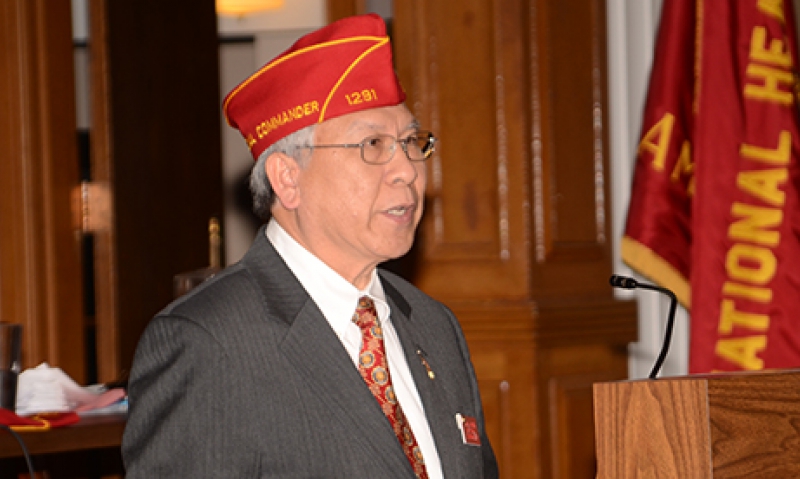
At Fall Meetings in Indianapolis, American Legion leader shares insights after intensive schedule of meetings earlier with members of Congress
American Legion National Commander Fang A. Wong had just spent several days in Washington, meeting with dozens of members of Congress and VA Secretary Eric Shinseki, when he arrived in Indianapolis last weekend for the organization's 2011 Fall Meetings.
The previous week's experience gave him plenty of material to discuss with department commanders, adjutants, members of the National Executive Committee and past national commanders. Wong shared the Legion's legislative agenda and raised concern about the security of veterans health care and national security as Washington eyes spending cuts to cope with the federal deficit crisis. Wong told his fellow Legionnaires about meetings he had the previous week with four of the 12 "supercommittee" members who are tasked with finding ways to reduce the federal deficit.
"A lot of them asked ... ‘What are you willing to give up?'" Wong told the NEC. "One senator asked me to draw a line in the sand so that they can protect us to that line. My answer was basically, ‘Senator, we don't even know what the sandbox looks like.'
"I walked away with mixed feelings. My argument to the senators and congressmen ... is we have 1 percent of Americans willing to serve, protecting us. We have 99 percent that are not serving. We have about 9 percent of the U.S. population who are veterans. So I asked them, ‘When you consider cutting ... please let the other 92 or 99 percent go first.' That 1 percent already paid their dues, and they shouldn't pay several times over."
Wong told the NEC that his meeting with Shinseki went well, although the commander was troubled after Shinseki told him that 50 percent of veterans using the Post-9/11 GI Bill for education expenses drop out during the first year. "He said that is totally unacceptable. When they drop out, all of the sudden they are unemployed."
Shinseki explained that many of the young men and women who leave the military for college have difficulty transitioning to a less-structured lifestyle, Wong told the group gathered in Indianapolis. VA has been dedicating more resources, including on-campus counselors, to help reverse the trend. "The young men and women, when they go back to school, they need someone ... to make sure they stay, at least through the first year," Wong said. "After the first year, the retention rate is a lot better."
Wong said Shinseki and he discussed ways Legion post around college campuses can offer support to student veterans as well.
Also during the Fall Meetings:
• Wong told the National Executive Committee that his primary fundraising efforts will focus on the Child Welfare Foundation. "That's a great program, and we need to make sure we support that," he said. "That's one of my projects. The other is (The American Legion Legacy Scholarship Fund). It's for the future. It's to take of those heroes that gave their lives to protect us. It's our turn to take care of their children."
• National Economic Commission Chairman Harold Barnett announced that the Legion will sponsor a national credentialing summit early next year. The summit will bring together key stakeholders to identify ways to improve credentialing opportunities for transitioning servicemembers and veterans.
• Ret. Maj. Gen. Jason Kamiya, senior vice president of USAA, presented Wong with a check for $1.24 million to help American Legion programs. USAA, the Legion's preferred provider of financial assistance, donates funds for the organization's programs when they join USAA and purchase insurance or banking products. USAA Bank also contributes to American Legion programs with every new American Legion USAA RewardsTM World MasterCard account opened and each time Legionnaires make eligible purchases with the card.
• More than $13,000 was raised for the National Emergency Fund and more than $6,400 for The American Legion Legacy Scholarship Fund during the NEC meetings.
Visit www.legion.org in the coming weeks for additional coverage of the 2011 Fall Meetings.
- Convention

